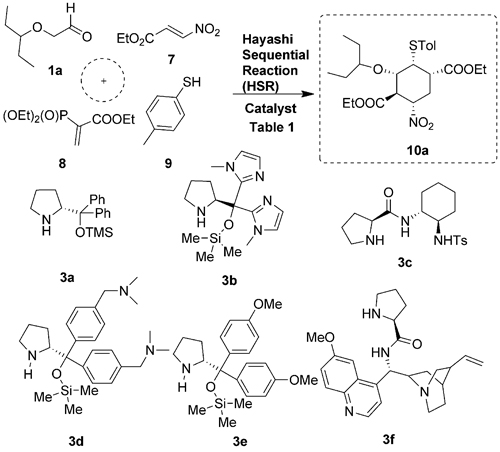The tertiary amine-modified diarylprolinol silyl ether 3d can be successfully used as an efficient organocatalyst in the sequential reaction of β-nitroacrylate, aldehydes, toluenethiol, and ethyl 2-(diethoxyphosphoryl)- acrylate, according to a recent study by researchers at Hangzhou Normal University and Lanzhou Institute of Chemical Physics.
Notably, this strategy improved the enantioselectivity from 87–95 %ee without affecting the conversion. The reaction proceeds with superior and complete regioselectivity with a very high enantioselectivity to furnish almost stereoisomerically pure, highly functionalized, polysubstituted cyclohexanes.
In addition, researchers have demonstrated an improved protocol for the domino oxa-Michael/aldol reaction of salicyladehydes with α,β-unsaturated aldehydes in which recyclable 3d was used as an effective organocatalyst. This protocol resulted in the formation of chiral chromenes with comparably good enantioselectivities (up to 94 %ee). Finally, UV/Vis and CD spectroscopy provide a cross-validation method, which elucidates the slight difference between electron-withdrawing tertiary amine-modified diarylprolinol silyl ether 3d and diphenylprolinol silyl ether 3a. This gives indirect evidence for the enhancement of enantioselective induction with 3d in these transformations.
The sequential reaction can be considered as one of the most powerful and reliable tools for the one-pot construction of complicated molecules from simple and commercially available substrates. The development of sequential one-pot enantioselective reactions is a new direction in organocatalysis. Asymmetric organocatalytic sequential reactions catalyzed by chiral amines, especially secondary amines, have grown rapidly to become one of the most exciting topics in asymmetric organocatalysis, as secondary amines are capable of both enamine and iminium catalysis. In particular, the incorporation of silyl groups in aminocatalysts, which allow steric and electronic modifications, has led to the enhancement in enantioselectivity and reactivity.
The work has been financially supported by National Natural Science Foundation of China (NSFC), Program for Excellent Young Teachers in Hangzhou Normal University (HNUEYT), and Hangzhou Science and Technology Program.
The work has been published in Eur. J. Org. Chem. (Eur. J. Org. Chem. 2011, 5031–5038).
Eur. J. Org. Chem.Paper

Screening of organocatalysts for the asymmetric HSR of β-nitroacrylate, aldehyde, toluenethiol, and ethyl 2-(diethoxyphosphoryl) acrylate.
